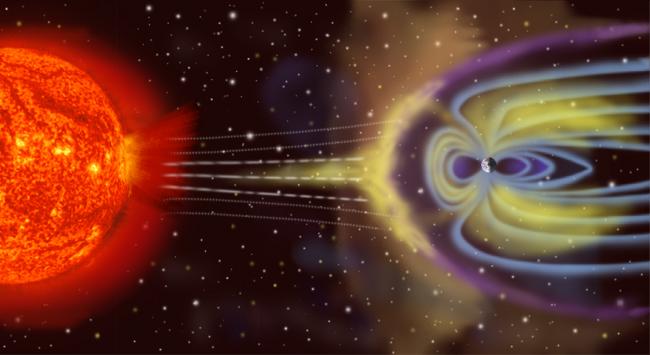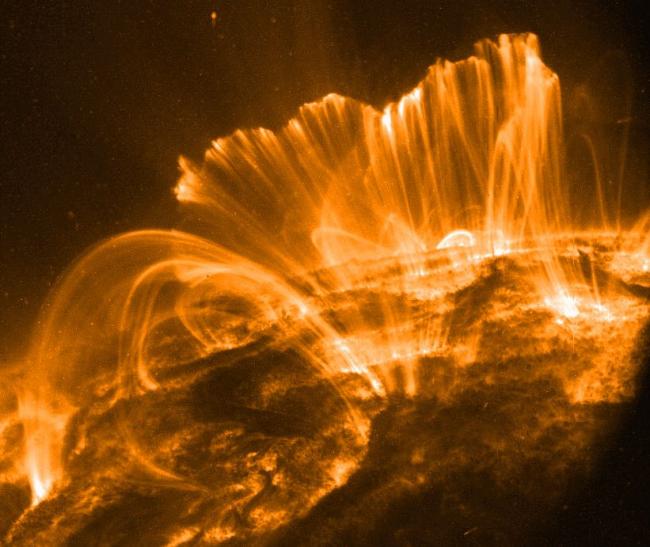ab tera kya hoga vardaan???


SOLAR STORM:
Solar storm can refer to:
Geomagnetic storm - the interaction of the Sun's outburst with Earth's magnetic field
Coronal mass ejection (CME)
Solar flare
A geomagnetic storm is a temporary disturbance of the Earth's magnetosphere caused by a disturbance in space weather. Associated with solar coronal mass ejections (CME), coronal holes, or solar flares, a geomagnetic storm is caused by a solar wind shock wave which typically strikes the Earth's magnetic field 8 days after the event. This only happens if the shock wave travels in a direction toward Earth. The solar wind pressure on the magnetosphere will increase or decrease depending on the Sun's activity. These solar wind pressure changes modify the electric currents in the ionosphere. Magnetic storms usually last 24 to 48 hours, but some may last for many days. In 1989, an electromagnetic storm disrupted power throughout most of Quebec and caused auroras as far south as Texas.
A coronal mass ejection (CME) is an ejection of material from the solar corona, usually observed with a white-light coronagraph.
Arcs rise above an active region on the surface of the Sun.The ejected material is a plasma consisting primarily of electrons and protons (in addition to small quantities of heavier elements such as helium, oxygen, and iron), plus the entraining coronal magnetic field.
A solar flare is a large explosion in the Sun's atmosphere that can release as much as 6 × 1025 joules of energy. The term is also used to refer to similar phenomena in other stars, where the term stellar flare applies.
Solar flares strongly influence the local space weather of the Earth. They produce streams of highly energetic particles in the solar wind and the Earth's magnetosphere that can present radiation hazards to spacecraft and astronauts. The soft X-ray flux of X class flares increases the ionization of the upper atmosphere, which can interfere with short-wave radio communication and can increase the drag on low orbiting satellites, leading to orbital decay. Energetic particles in the magnetosphere contribute to the aurora borealis and aurora australis.
Solar flares release a cascade of high energy particles known as a proton storm. Protons can pass through the human body, doing biochemical damage.[4] The proton storms are produced in the solar wind, and hence present a hazard to astronauts during interplanetary travel. Most proton storms take two or more hours from the time of visual detection to reach Earth's orbit. A solar flare on January 20, 2005 released the highest concentration of protons ever directly measured,[5] taking only 15 minutes after observation to reach Earth, indicating a velocity of approximately one-half light speed.
The radiation risks posted by prominences and coronal mass ejections (CMEs) are among the major concerns in discussions of manned missions to Mars, the moon, or any other planets. Some kind of physical or magnetic shielding would be required to protect the astronauts. Originally it was thought that astronauts would have two hours time to get into shelter, but based on the January 20, 2005 event, they may have as little as 15 minutes to do so. Energy in the form of hard x-rays are considered dangerous to spacecraft and are generally the result of large plasma ejection in the upper chromosphere
Current methods of flare prediction are problematic, and there is no certain indication that an active region on the Sun will produce a flare. However, many properties of sunspots and active regions correlate with flaring. For example, magnetically complex regions (based on line-of-sight magnetic field) called delta spots produce most large flares. A simple scheme of sunspot classification due to McIntosh is commonly used as a starting point for flare prediction. Predictions are usually stated in terms of probabilities for occurrence of flares above M or X GOES class with 24 or 48 hours. The U.S. National Oceanic and Atmospheric Administration (NOAA) issues forecasts of this kind.
it will disrupt all communication systems.
-
UP 0 DOWN 0 0 7

7 Answers
So are we supposed to panic or what?? Lol...go study vardaan. It will do you good.
u should have additional knowledge also.bookworm banne se koi fayda nahi pritish ...lol
Trust me, I have searched and scourged through Wikipedia and Google much more than you have and ever will...indeed, bookworm banne se koi fayda nahi, magar yahan baithke aise time waste karne se bhi koi fayda nahi hai. It won't get you a good college.
Thanks for this "additional" info however. After all, that's what you wanted, isn't it? Recognition? :)
ROFL. This is kinda weird discussion after-all! Dudes, there are more better ways to pass time (if you want).
thats right i trust u and this is the reason i m forcing u to read.AND RECOGNITION,I M NOT THIRSTY FOR IT LIKE U M Y DEAR.LOL
AREY YAAR KAHE BAKWAS MEIN LAGE HO U KNOW THIS IS THE WAY """india news"""" TLKS VARDAAN........EVERY YEAR THERE R MANY SUCH NEWS....AB KYA DAR DAR KE JIYOGE????JAB MARNE WALE HOGE TABHI MAROGE lol!!!!!!!!!......MARNE SE PEHLE WHY U WANNA DIE OF PANIC EVERY SECOND??